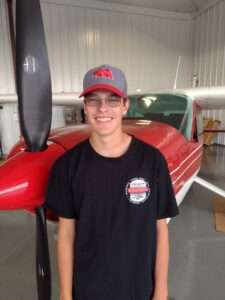BY: CINDY GONZALEZ

A teen from Grant, Nebraska, has been recognized as one of the country’s most promising STEM middle schoolers — named this week as a contest finalist headed to Washington D.C., to compete for roughly $100,000 in awards.
Cooper Kroeker, now 15, is among 30 youths (and the only Nebraskan) selected from 1,807 applicants in the annual Broadcom MASTERS (Math, Applied Science, Technology and Engineering for Rising Stars).
Already, the product of Perkins County Schools in western Nebraska has won $500, and his teachers get a one-year subscription to Science News magazine and $1,000 for science, technology, engineering and math STEM activities.
The Society for Science Broadcom sponsors seek to inspire young people to work toward solving the grand challenges of the future.
“These extraordinary students are looking for solutions to some of the world’s most intractable problems,” said Maya Ajmera, president and CEO of Society for Science. “I commend these young people for their hard work to make the world a better place.”
In Cooper’s case, he said his work was inspired by his parents, the family farm and airplane and his hobby of flying.
“We get to see the impacts of climate change firsthand,” he told judges.
The teen used data from test flights and research on representative airplanes to see how climate change will affect aviation.
He found that longer takeoff distances will be needed, so airports and planes will need to make adjustments, such as longer runways or less weight on aircraft.
One of the aspiring scientists he’ll compete against explored the physics behind throwing a curveball. A sampling of others looked at: inventing an inexpensive robotic hand; mitigating harmful emissions from rockets; Alzheimer’s biomarkers in cerebrospinal fluid; training a neural network to warn people of deadly earthquakes.
And don’t forget the kid from Hershey, Pennsylvania, who examined: The effect upon closure dynamics of the application of weak acids to the pulvinus of the venus fly trap.
Finalists represent 12 states In October they will compete further for scholarships and prizes in the nation’s capital. Sixteen in the group attended public schools when they produced their projects, 10 were in private schools, three were in charter schools and one attended a magnet school.
While in Washington, they’ll be judged on their research projects as well as collaboration and critical thinking skills during team challenges. Awards collectively amounting to about $100,000 are in play.

Cooper’s project
Cooper’s work is titled: Effects of Global Temperature Increase on Aviation. Here’s a glimpse at the project, as provided by contest sponsors:
Background: His science teacher encouraged students to do something unique and personally enjoyable for the science fair. Cooper, who plans to get his pilot’s license, started wondering about how climate change would affect aviation. “I decided that density altitude would be a good place to start.”
As temperature and distance above the ground increase, the density of the air decreases.
“How does the temperature impact the density altitude?” Cooper asked. “And how does that impact takeoff distances?”
The takeoff distance is how far a plane needs to run on the ground before it lifts off, plus the distance between that point and a certain altitude, such as 50 feet or 15 meters.
Tactics and Results: Cooper went to a nearby airport with his dad, and they took off on a variety of days with different temperatures. Each time, Cooper collected data, including the temperature, dew point, density altitude and more. Then he analyzed the data.
“The results proved that temperature increase causes takeoff distances to increase,” he said.
He also did research on representative airplanes at large cargo and passenger airports. He compared the takeoff distances to existing runways on a standard day. He also looked at the takeoff distances for the average daily high temperature for the hottest month. Using this data, he figured out what the distances would be for a day that was 5 degrees Fahrenheit warmer (roughly 2.8 degrees Celsius).
“Airplanes will have to compensate for the higher temperatures,” he says. For example, the planes might need to take off at a higher speed. Or, they might need to limit their fuel or payload. Also, he adds, “Airports will have to compensate by building longer runways or limiting certain aircraft.”
Other interests: “I am very interested in plants and gardening,” Cooper says. A career as a botanist could let him learn more about plants and perhaps help develop new hybrids, he thinks.
He plays football and basketball, runs track and lifts weights in the summer. He plays the bassoon, saxophone and clarinet. He likes public speaking.
“I also enjoy just building stuff,” he adds. Most times he makes something he needs. “But every once in a while, I’ll invent something new,” he says.



